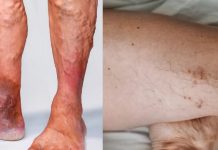Overview, Causes, & Risk Factors
Deep venous thrombosis, also called DVT, refers to a blood clot that has formedin one of the large veins far below the skin.
What is going on in the body?
A deep venous thrombosis is most common in the legs, but it can occur in otherparts of the body. A blood clot in a vein blocks the normal flow of blood backto the heart. It also causes the affected vein to become inflamed.
What are the causes and risks of the condition?
A deep venous thrombosis forms when a blood clot in a vein blocks the normalflow of blood back to the heart. Circumstances that increase an individual’srisk of developing DVT include:
Diseases and conditions that increase a person’s risk for DVTinclude:
Medicines that can increase the risk for DVT include:
Injuries can also increase a person’s risk for DVT. Common injurieslinked to DVT include:
Recently, there have been conflicting research reports about the role of longairplane flights in deep venous thrombosis. Some studies showed a relationshipbetween airline travel and an increase in the blood’s tendency to form clots.The researchers attributed the increased risk of clot formation to the lowpressure, low oxygen, dehydration, and lack of activity on long flights. Another studyshowed that individuals hospitalized with DVT were four times more likely tohave gone on a long trip recently than those treated at the hospital for otherconditions. Because of findings like this, deep venous thrombosis is oftenreferred to as “economy class syndrome.”
However, otherresearchers have not found the same relationship. Some suggest that only peoplewith a particular genetic abnormality are at risk for economy class syndrome.More research is needed in this area.
Symptoms & Signs
What are the signs and symptoms of the condition?
Following are some of the symptoms of a deep venous thrombosis:
Diagnosis & Tests
How is the condition diagnosed?
The first step in diagnosing a deep venous thrombosis is a medical history andphysical examination. Blood flow studies, a type of ultrasound, arecommonly used to diagnose DVT. The healthcare provider may also order anMRI or other imagingstudies.
Prevention & Expectations
What can be done to prevent the condition?
DVT cannot always be prevented. Some helpful measures include:
Although the research is still inconclusive about the effects of airplane tripsand other forms of travel on DVT, people can lower their risk of DVT by takingthese steps:
Blood-thinning medicines can help prevent DVT. These include heparin,enoxaparin, and warfarin. Compression stockings can also be used to improve theflow of blood through the veins back up to the heart.
A recent large-scale study in Canada looked at DVT in individuals 65years or older. The study found that statins, which are medicines used to lowercholesterol, decreased therisk of DVT by 22% in this group. While further study is recommended, thefindings are encouraging.
What are the long-term effects of the condition?
Most patients will recover from an episode of deep venous thrombosis withoutlong-term problems. People who have had DVT have a higher risk of getting itagain. The most serious risk of DVT is a pulmonary embolus. This isa piece of the blood clot that breaks off and travels to the lung. A blood clotin the lung can cause death.
DVT may also cause chronic pain and swelling of the affected leg. There arerare cases of a stroke resulting from a DVT.
What are the risks to others?
A deep venous thrombosis is not contagious and poses no risk to others.
Treatment & Monitoring
What are the treatments for the condition?
Treatment of a deep venous thrombosis focuses on preventing a pulmonaryembolus. Bed rest and elevating the leg can help reduce the swelling and pain.The person is often given an injection of a blood-thinning medicine. Theinjection may be given through an IV or under the skin. These blood-thinningmedicines, such as heparin and enoxaparin, help prevent further growth of theblood clot. After a few days of blood-thinning medicines by injection, theperson can be switched to pills. Warfarin is the most common blood-thinningpill.
In some people, blood-thinning medicines cannot be used. For example, a personmay have a high risk of bleeding, a side effect of thinning the blood. In thesecases, a surgical procedure can be done. This involves inserting a filter inone of the major veins of the body that leads to the heart. This filter catchesany clots that break off so they cannot get into the lungs and causedeath.
What are the side effects of the treatments?
Heparin can cause bleeding and lower blood platelet counts, calledthrombocytopenia. Warfarin can also cause bleeding, which in rare cases isfatal. Warfarin interferes with many other medicines. Surgery can causebleeding, infection, or allergicreaction to anesthesia.
What happens after treatment for the condition?
Most patients with a deep venous thrombosis will recover fully. When DVT is inthe pelvis or upper leg, warfarin is usually taken for at least 3 to 6 months.DVT in the veins of the calf is usually treated with warfarin for at least 6weeks.
In people who develop a second DVT, warfarin treatment is continued for life.This long-term therapy is also used in people with underlying causes of DVT,such as cancer or acondition referred to as thick blood.
How is the condition monitored?
People with a history of deep venous thrombosis are told to avoid prolongedperiods of immobility. They also need to watch for the common symptoms of legpain and swelling. Individuals on blood-thinning medicines will have periodicblood tests to monitor the thickness of their blood. Any new or worseningsymptoms should be reported to the healthcare provider.
Article type: xmedgeneral














































